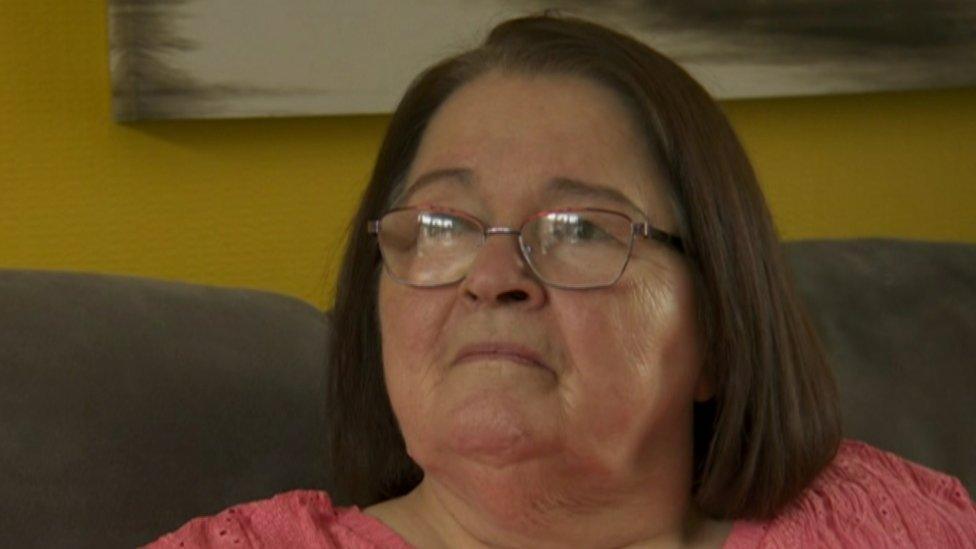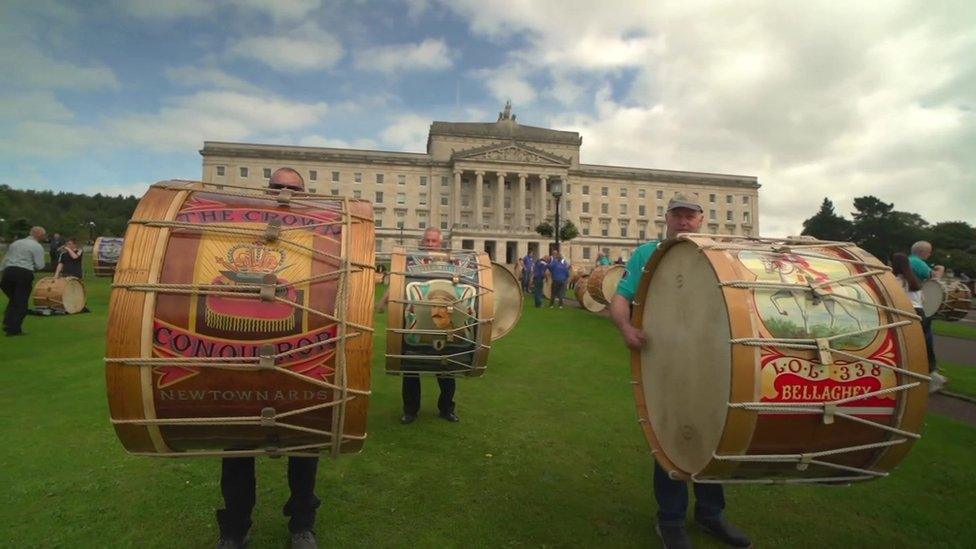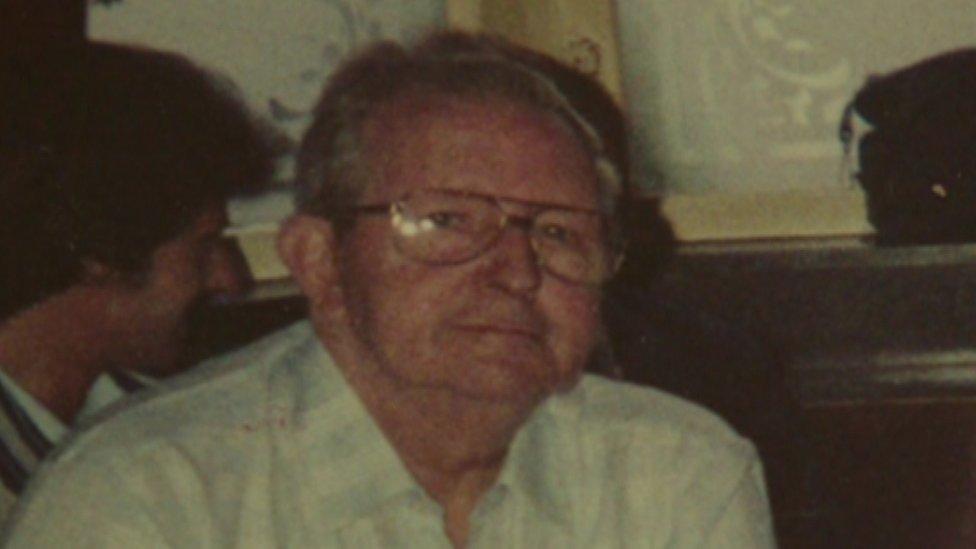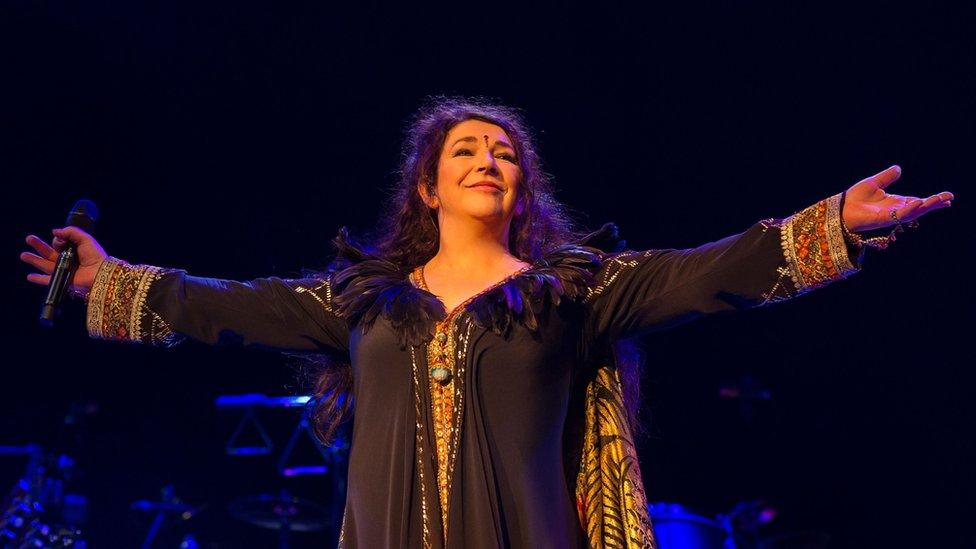Kate Bush: The Lambeg that gave Running Up That Hill its thunder
- Published
Singer Kate Bush ordered a Lambeg drum from a shop in Belfast
One of Northern Ireland's most mysterious musical stories has been given new life by the resurgence of one of the most famous pop songs of the 80s.
On one side - Kate Bush, the enigmatic singer-songwriter, and Running Up That Hill, which has hit number one in the UK charts a full 37 years after its original release.
Back then, the song went to number three in the charts but thanks to prominent usage in Netflix's horror smash Stranger Things, it will become Bush's second number one of her career, a mere 44 years after Wuthering Heights.
On the other side, the Lambeg drum - Northern Ireland's most iconic musical instrument, a seriously loud and huge piece of kit with a booming sound made famous by street parades.
Unlikely musical bedfellows perhaps - but no better way to ring out Running Up That Hill's "thunder in our hearts" than with the thunderous timbre of the Lambeg.
Kate Bush, one of the biggest pop stars in the world at the time, seemed to think so.
Allow YouTube content?
This article contains content provided by Google YouTube. We ask for your permission before anything is loaded, as they may be using cookies and other technologies. You may want to read Google’s cookie policy, external and privacy policy, external before accepting. To view this content choose ‘accept and continue’.
Which is why William Hewitt, a drum maker on Sandy Row in Belfast, found himself with a strange request back in the early 1980s - and why the singer ended up with a bespoke drum, adorned with white fluffy clouds and apparently dubbed The Cloudbuster.
Elizabeth McKinley, William's daughter, told BBC News NI all about how her father - who "wasn't really an excitable man at the best of times" - came home to tell her the star had come into his Drum Sounds shop.

Elizabeth McKinley, whose father William Hewitt made the Lambeg for Kate Bush
"She'd come into the shop with two young boys and apparently they were members of the band and someone had put her in the direction of my father as the drum maker - and he said 'you'll never guess who she was?', and he told us it was Kate Bush. He was very happy about it.
"He knew of her music, that would've been all - never would've dreamt he would've met her."
The mystery of The Cloudbuster
The story of Kate Bush and the Lambeg has taken on mythical status in Northern Ireland music circles.
Bush, famously reclusive, hasn't released any new music in 11 years, almost never gives interviews and rarely plays gigs - her first run of concerts since 1979 came eight years ago.
Her music has occasionally returned to prominence in the years since her heyday in the 80s and early 90s - for instance, when The Futureheads yodelled-up cover of Hounds of Love turned into an indie hit in 2004.
But for the most part, Bush and her music remains an enigma - and likewise, so does The Cloudbuster. She has never spoken about it and its status is unknown. Meanwhile, William Hewitt, its maker, has since died.
However, Northern Ireland music journalist Stuart Bailie and former musician Mike Edgar took up the story in an online video posted in 2020, external.
In it, Edgar - a member of Cruella De Ville, a Belfast-based band signed to record label giants EMI in the 1980s - recalled how his A&R man John Bagnall, who also represented Kate Bush, asked him if he could source a Lambeg for her. She had seen one on TV and wanted to know if she could get her own.
Perhaps it shouldn't have been that surprising that Kate Bush would look to this side of the Irish Sea for musical inspiration.
Her mother, Hannah Daly, was from Waterford in the Republic of Ireland and an Irish dancer. The album Hounds of Love would go to feature a track called Jig of Life, which included an extended coda of traditional Irish music.
Renowned traditional Irish musicians Dónal Lunny, John Sheahan and Liam O'Flynn played on the record.
Despite famously composing much of Hounds of Love on a synthesizer - the Fairlight CMI - she melded those electronic sounds with acoustic folk instruments, such as balalaikas, bouzoukis and didgeridoos. And, of course, the Lambeg.

Lambeg drums are usually painted with designs reflecting Orange or unionist culture in Northern Ireland
According to Edgar, it was he who put the initial calls in to William Hewitt to arrange the drum to be made. He also recalled how it came to be painted with clouds.
Lambegs are traditionally associated with parades across Northern Ireland, with drummers beating out marching tunes. Usually they are painted with images associated with the Orange Order. But Kate Bush's request was a little out of the ordinary.
"She had a particular picture she wanted on it," said Elizabeth McKinley. "And father was used to doing the like of King Billy (King William of Orange) or orange lillies. But he had done banners so was quite a good painter, he was able to do the clouds and the picture from what she described she wanted."
Elizabeth said it was Bush herself who came to get the drum and that she later wrote to thank her father.
"It's just a lovely thank you letter and it was handwritten and signed 'Kate Bush' - I have it somewhere. Somewhere among memorabilia…"

William Hewitt
She also said Bush sent her father a video clip of the drum being used when recording the album.
The drum, said Elizabeth, would have cost £300 or £350 in those days but now, even without being used by a beloved pop star, a brand new Lambeg would fetch about £4,000.
Those handmade drums - about 40 or 50 that William Hewitt would have made during his career - are still around, said Elizabeth. "They're all out there somewhere, a lot of Lambeg men in the country have bought them and collected them over the years."
She added: "I was very proud of him. Proud of the banners every Twelfth, to stand and watch those banners come down - and certain drums would have my father's stamp on them and I would've known there's my father's (drum) heads. My father put the heads on that drum."
The drums are William Hewitt's legacy. And, now, so is the UK's number one single, finally at the top of the charts almost four decades after he tightened the drumheads on what would come to be known as The Cloudbuster.
Now, when Elizabeth hears the song and tells this story she thinks of him. She added: "I think about him all the time."
- Published17 June 2022

- Published14 June 2022

- Published16 April 2021

- Published1 June 2022

- Published18 September 2021

- Published10 November 2016

- Published27 May 2022

- Published6 October 2020
